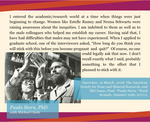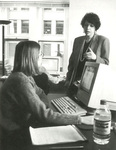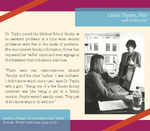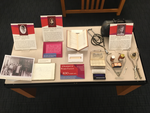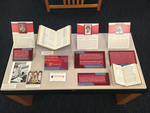Introduction
Snapshots of Women Faculty was created to celebrate 100+ years of women working in research and education at Northwestern University Medical School (NUMS), now known as the Feinberg School of Medicine. This exhibit provides a momentary glimpse into the lives and work of women faculty from 25, 50, 75, and 100 years ago.
Though they have always been caregivers and healers, women have long endured prejudice, obstacles, and limited opportunities when formally pursuing work in the health sciences. Specifically in academic medicine, women were often pigeon-holed into certain specialties with which they were deemed compatible, or they chose fields which men had effectively overlooked, such as the care of women, children, and mental illness. Women were often kept at lower ranks than their male peers, serving as instructors and assistants, or never making the rank of a full professor. Augusta Webster, MD 1932, one of the first women to earn an MD from NUMS, was also the first woman to be promoted to a full professorship here in 1960, when the medical school turned 101 years old.
Through this exhibit we hope to recognize and celebrate the careers of women over a span of decades at FSM, while also showing the disparity and hardships that were present for them. Snapshots of Women Faculty celebrates women who succeeded in a field long considered inappropriate for or incompatible with women. Whether they knew it or not, these women were breaking ground and making the pathway to practice medicine and research more accessible.
This exhibit was designed to accompany the NLM traveling exhibition, Rise, Serve, Lead! America’s Women Physicians, which was to appear at Galter Library September 27 to November 6, 2021. Because of restrictions put in place during COVID-19 pandemic, Rise, Serve, Lead! was never exhibited.
Women have always been healers. To join the ranks of professional physicians, women had to overcome obstacles and fight to practice medicine. They rose to the challenge and have served as doctors for nearly two hundred years.
By rising to meet challenges, serving their communities, and leading at home and abroad, America’s women physicians make medicine more equitable, diverse, and effective.
Credits
Curated by Katie Lattal, MA, Special Collections Librarian; Ramune Kubilius, MALS, AHIP, Collection Development / Special Projects Librarian; Annette Mendoza, MLIS, former Research Impact Librarian; Corinne Miller, MLIS, Clinical Informationist; Annie Wescott, MLIS, Research Librarian; and Emma Wilson, Library Assistant.
Designed by Katie Lattal.
1921: 100 Years Ago
Anna R. Lapham, MA, MD (1869–1953)
Position in 1921: Demonstrator, Operative Obstetrics
Years at NU: 1919-1953
Anna Lapham was the first woman faculty member at Northwestern University Medical School. She became an assistant professor in 1926, when the Medical School began admitting women (she served as the unofficial Dean of Women during this time, too). Lapham was an attending obstetrician at Chicago Lying-In Hospital, a maternity hospital that provided high quality care to women of all races and classes. She obtained emerita status in 1946.
 Reba C. Haner, MS (1896–1982)
Reba C. Haner, MS (1896–1982)
Position in 1921: Assistant, Bacteriology
Years at NU: 1920-1925
 Melanie Schilling, MS (1898–1997)*
Melanie Schilling, MS (1898–1997)*
Position in 1921: Assistant, Clinical Pathology
Years at NU: 1921-1934
Margaret Wilson, PhD, MD (1894–1954)
Position in 1921: Assistant, Anatomy
Years at NU: 1919-1921
Margaret had a rare gift also to lead students imaginatively to consider the meaning of one person to another in a specific social context, the bigness of small things in the life of a child, the profound import in general of child to parent and parent to child, and, specifically now, their need of one another in a stress situation.
Towle, Charlotte. “In Memoriam: Margaret Wilson Gerard, M.D., 1894-1954,” Social Service Review. June 1954, 28(2):216.
1946: 75 Years Ago
 Beatrice E. Tucker, MD (1897–1984)
Beatrice E. Tucker, MD (1897–1984)
Position in 1946: Associate Professor, Obstetrics & Gynecology
Years at NU: 1933-1984
I was one of the nurses that worked there [Chicago Maternity Center]. I became familiar with the center as a student nurse and was employed there after graduating from nursing school. Dr. Tucker was a remarkable individual that truly believed in birth as a natural process, that involved the family as an integral part of the birthing experience. Birth was an incredible miracle not with the wailing, drugs and paternalism of the hospital experience that I saw in my OB experience. As a young nurse it was remarkable and as a young woman an eye openerto the beauty and miracle of birth. Thank you, Maternity Center and Dr. Beatrice Tucker.
Mary Amari, RN. Quoted in “Dr Beatrice Tucker: Home Birth for Chicago's Working Class,” Chicago Women’s Liberation Union Herstory Project.
I believe in home obstetrics. I think a woman has the right to choose where she wants to have her baby.
Beatrice Tucker, Chicago Daily News, March 15, 1973.
The national maternal death rate in the 1930s was 1 per 175. The [Chicago Maternity] center’s record at the time was less than 1 death per 1,200 births… The center’s insistence on absolute cleanliness surrounding the mother, coupled with the home setting, where the mother was not exposed to external sources of contagion, was part of the reason for the center’s success.Schultz, Rima and Adele Hast, editors. Women Building Chicago: 1790-1990: a biographical dictionary. Bloomington, Ind.: Indiana University Press, 2001, p. 896.
María Ramírez de Arellano, PhD, MD (1915–2017) 
Position in 1946: Fellow, Institute of Neurology
Years at NU: 1938-1951 (as student & fellow)
Edith B. Farnsworth, MD, MS (1903–1977)
Position in 1946: Associate Professor, Medicine
Years at NU: 1942-1969
Edith Farnsworth, on her work on nephritis:
Those dim hours spent beside the bed of poor [name redacted] opened for me a series of meditations, not only on hospital life and death, the obligations and the privileges of the attending and the house staffs, but on concepts of diseases, particularly the pathogenesis of nephritis.. . .[Nephritis], first described around 1826 by Richard Bright and never subsequently challenged now appeared in a totally different light... The more I pondered, the more the “classical” theories seemed crude and naïve and the new possibilities seemed likely and worthy of exploration.. . .I was interested in the diseases characterized by massive edema, namely, hepatic cirrhosis, cardiac decompensation and nephritis and wanted to use ACTH as a research tool, hoping thereby to throw light upon the mechanism of the water-retention in the three situations.. . .My line of reasoning was simple: if the renal tubules were acting under excessive stimulation and thereby reabsorbing excessive quantities of sodium and chloride, they might well respond differently to bombardment by ACTH, on the principle that a tired horse, if whipped, will behave differently from the horse which is fresh and rearing to go.. . .Before long we had consistent data from six or eight cases representing various phases of nephritis–enough for the preliminary report required by Dr. Mote for the first conference on ACTH, to be held in October of 1949.Edith Farnsworth Papers, 1900-1977. The Newberry Library, Chicago. Partially available on archive.org.
Designed by International Style leader Ludwig Mies van der Rohe and constructed from 1949-1951, the Farnsworth House represents the apex of Mies van der Rohe’s American career. Built as a country house for Edith Farnsworth, a single woman sympathetic to his aesthetic aims, the house comes as close as Mies van der Rohe ever came to achieving his vision of “beinahe nichts” or “almost nothing,” the reduction of every element to its essence.Notes, Historic American Buildings Survey (HABS) IL-1105. Library of Congress.
In the summer, the glass box—essentially a greenhouse—suffered from insufficient ventilation, fully steamed-up windows, and a lack of air-conditioning. “You feel as though you are in a car in the rain with a windshield wiper that doesn’t work,” Farnsworth told Newsweek.Grace Perry, “Remembering the Farnsworth House Feud,” Chicago Magazine, March 16, 2020.
1971: 50 Years Ago
Niles R. Newton, PhD (1923–1993)
Position in 1971: Associate Professor, Psychiatry
Years at NU: 1966-1993
Alongside the names of famous men like Grantly Dick-Read and Benjamin Spock appears the name of Niles Newton. La Leche League selected Newton’s (1957) The Family Book of Child Care as their go-to parenting manual, preferring it even to Dr. Spock’s (1946) bestselling guide, The Common Sense Book of Baby and Child Care. Their recommendation makes sense given that La Leche League was critical of Spock for his book’s emphasis on formula making and feeding. La Leche League instead praised Newton’s book specifically for its novel presumption that an infant would, of course, be breastfed (La Leche League International, 1963, pp. 141-146). The assumption that breastfeeding was the obvious way to feed an infant, however, was exceedingly rare in the 1940s and remained so through the next 2 decades. So who was this Niles R. Newton, and how is it that, whereas names like Spock and even Read remain very well known in the history of maternity and childcare, few people (historian or otherwise) react with any recognition to her name?Martucci, Jessica. “The Life and Legacy of Niles Polk Rumely Newton: Breastfeeding Researcher, Advocate, and Mother, 1923-1993.” Journal of Human Lactation. 2018 34(3):507.
We must find more ways to help women feel good about mothering, wifing and comfortably using their unique female biological functions. True female self-esteem comes not from being just like men but enjoying the differences.Newton, Niles. Newton on birth and women: selected works of Niles Newton, both classic and current. Seattle, WA: Birth & Life Bookstore, 1990: 1.
Under Mead’s influence, Newton…began to articulate a perspective of the maternal body as a living and material source of truth, one that existed, in some small way, beyond the reach of the patriarchal social and cultural systems in which women lived. In making this shift, Newton began building a philosophical orientation that not only would underpin the entire back-to-the-breast movement, but it would eventually be recognizable in the radical politics of the women’s health movement, where women would learn to seek power and political identity through embracing their embodiment as women.Martucci, Jessica. “The Life and Legacy of Niles Polk Rumely Newton." *this quotation did not appear in exhibit due to space constraints
Opal E. Hepler, PhD, MD (1899–1993)
Position in 1971: Professor Emerita, Pathology
Years at NU: 1929-1993
Most laboratory workers were women. A few men did go into histological technique, but now more men are entering the medical technology profession. Pathologists did their own lab work or trained their own technicians.Hepler in: Kahn, "A Laboratory Medicine Profile: Dr. Opal Hepler—Pathologist, Author, Teacher," Laboratory Medicine 6, no. 3 (March 1975): 9.
Ruth K. Freinkel, MD (1926–2014)
Position in 1971: Associate Professor, Dermatology
Years at NU: 1966-1995
You were a pioneer. Were you often the only woman?Mostly in everything I did I was the only woman. Those were different times. There weren’t many women [in medicine] and women didn’t do research. If they went into medicine at all, they were nurses or maybe some kind of doctors, but they didn’t do research.. . .Did you recognize that you were a trailblazer in research?You know, when you’re blazing trails you don’t really know it; you know you just move ahead and try not to step into the manure.Ruth Freinkel interview with Amy Paller, June 28, 2010. The Society for Investigative Dermatology. 2014 134: 2670.
1996: 25 Years Ago
Sandra F. Olson, MD
Position in 1996: Associate Professor, Clinical Neurology
Years at NU: 1969-present
 Cheryl E. Woodson, MD
Cheryl E. Woodson, MD
Position in 1996: Assistant Professor, Medicine
Years at NU: 1991-1996
 Paula H. Stern, PhD
Paula H. Stern, PhD
Position in 1996: Professor, Pharmacology
Years at NU: 1966-present
 Linda A. Teplin, PhD
Linda A. Teplin, PhD
Position in 1996: Professor, Psychiatry & Behavioral Sciences
Years at NU: 1976-present
Archival Sources
- Arthur Kendall presentation album. 2016.15.0020. Galter Health Sciences Library Special Collections, Chicago, IL.
- Edith Farnsworth Papers, 1900-1977. The Newberry Library, Chicago. https://archive.org/details/mms_farnsworth/page/n17/mode/thumb.
- “Medical technologist.” Publicity Photographs: Prints, Negatives, Contact sheets, 1978-1990. 2018.17.110. Galter Health Sciences Library Special Collections, Chicago, IL.
- Schwartz, Leslie, photographer. “General view from the southwest, showing south elevation - Edith Farnsworth House, 14520 River Road, Plano, Kendall County, IL.” Photograph. Historic American Buildings Survey IL-1105. Library of Congress Prints and Photographs Division Washington, D.C. https://www.loc.gov/item/il0323/.
Published Sources
- "Anna Lapham Dies; 1st Woman Doctor at N.U." Chicago Daily Tribune, April 1, 1953.
- Arey, Leslie. Northwestern University Medical School 1859- 1979: A Pioneer in Educational Reform. 2nd, revised and extended ed. Chicago: Northwestern University, 1979.
- Chicago Maternity Center. "Annual Report," 15 (1947): facing p. 1.
- Chicago Medical Society. History of Medicine and Surgery and Physicians and Surgeons of Chicago. Chicago: The Biographical Publishing Corporation, 1922.
- "Class of ’96 Has Female Majority." Ward Rounds 9, no. 4 (Winter 1992-1993): 34.
- "Dr Beatrice Tucker: Home Birth for Chicago's Working Class." 2012, https://www.cwluherstory.org/text-memoirs-articles/dr-beatrice-tucker.
- De Lee, Joseph B. The Technic of the Chicago Lying-in Hospital and Dispensary. Chicago: Chicago Lying-in Hospital and Dispensary, 1921.
- Elliot, Susan. "Personal Priorities." Ward Rounds 13, no. 2 (Summer 1996): 4-11.
- "Ex-Owner of Mies-Created Farnsworth House Dies." [Obituary.] Chicago Tribune, December 14, 1977.
- Farnsworth, Edith B. "Poems of Edith Farnsworth." Northwestern University Medical School Magazine 7, no. 1 (Winter 1969): 18.
- "Freinkel, Ruth Kimmelstiel." In American Men & Women of Science: A Biographical Directory of Today's Leaders in Physical, Biological, and Related Sciences. Edited by Andrea Kovacs Henderson. Detroit: Gale, 2009.
- Gerard, Margaret Wilson. The Emotionally Disturbed Child: Papers on Diagnosis, Treatment and Care. New York: Child Welfare League of America, Inc., 1956.
- Golden, Madelon. "Mother Wins Her M.D. Degree." Chicago Sun-Times, June 11 1950.
- Guggenheim, Joseph. "1895-1973 | the Chicago Maternity Center: An Important Chapter in Obstetrics." Northwestern Medicine Magazine (Spring 2021): 41. https://magazine.nm.org/2021/05/22/1895-1973-the-chicago-maternity-center-an-important-chapter-in-obstetrics/.
- Heise, Kenan. "Hospital Founder A.W. Hall." Obituary, Chicago Tribune, April 19 1991.
- ———. "Niles Polk Newton, 70, Pioneering Birth Expert." Obituary, Chicago Tribune, October 6 1993.
- Hepler, Opal E. Manual of Clinical Laboratory Methods. 4th ed. Springfield, Ill: C. C. Thomas, 1949.
- "Hepler." [Death Notice.] Chicago Tribune, June 13, 1993.
- [Interview with Beatrice Tucker.] Chicago Daily News, March 15 1973. Quoted in Schultz & Hast (see below).
- Kahn, Ada P. "A Laboratory Medicine Profile: Dr. Opal Hepler—Pathologist, Author, Teacher." Laboratory Medicine 6, no. 3 (March 1975): 8-11.
- Lawrence, Ruth. "Niles Newton: A Tribute." Birth 21, no. 1 (March 1994).
- Lieberman, K. V., and A. Pavlova-Wolf. "Adrenocorticotropic Hormone Therapy for the Treatment of Idiopathic Nephrotic Syndrome in Children and Young Adults: A Systematic Review of Early Clinical Studies with Contemporary Relevance." [In eng]. J Nephrol 30, no. 1 (Feb 2017): 35-44. https://doi.org/10.1007/s40620-016-0308-3.
- "Margaret Gerard, Child Psychiatrist, Author, Dies at 59." [Obituary.] Chicago Daily Tribune, January 13, 1954.
- Martucci, Jessica. "The Life and Legacy of Niles Polk Rumely Newton: Breastfeeding Researcher, Advocate, and Mother, 1923-1993." Journal of Human Lactation 34, no. 3 (2018): 507-14. https://doi.org/10.1177/0890334418776644.
- "Melanie Anne Schilling Katter." Find a Grave. https://www.findagrave.com/memorial/113909329/melanie-anne-katter.
- McComas, Paul. "Paula Stern." Ward Rounds 6, no. 2 (Summer 1989): 4-12.
- Newton, Niles. The Family Book of Child Care. [1st ] ed. New York: Harper, 1957.
- ———. Newton on Birth and Women: Selected Works of Niles Newton, Both Classic and Current. Seattle, WA: Birth & Life Bookstore, 1990.
- Northwestern University Medical School. "Medical School Announcements." Northwestern University Bulletin.
- Nyquist, Michael. "Hitting the Streets for Public Health Research." Ward Rounds 8, no. 1 (Spring 1991): 28-29.
- ———. "A Place in History." Ward Rounds 12, no. 4 (Winter 1995-1996): 4-11.
- "Obituary of Ruth Freinkel." Accessed February 1, 2016, https://musgroves.com/tribute/details/187173/Ruth-Freinkel/obituary.html#content-start.
- Paller, A. S., and E. A. Bauer. "Ruth Kimmelstiel Freinkel (1926-2014)." [In eng]. J Invest Dermatol 134, no. 11 (Nov 2014): 2669-70. https://doi.org/10.1038/jid.2014.386.
- Paula Stern, Ph.D. 2018. ASBMR e-News Weekly.
- Perry, Grace. "Remembering the Farnsworth House Feud." Chicago. (March 16 2020). https://www.chicagomag.com/chicago-magazine/april-2020/five-things-about-farnsworth-house/.
- Ramírez de Arellano, A. B. "A “Class a” Institution: The Struggle for the University of Puerto Rice School of Medicine." Puerto Rico Health Sciences Journal 8, no. 2 (August 1989): 265-70.
- Schultz, Rima Lunin, and Adele Hast, eds. Women Building Chicago 1790-1990: A Biographical Dictionary. Bloomington, IN: Indiana University Press, 2001.
- SooHoo, Cheryl. "Go Directly to Jail." Ward Rounds 15, no. 4 (Winter 1998-1999): 12-19.
- "Then: Trailblazing Doctor." 2015. Northwestern Magazine. https://www.northwestern.edu/magazine/fall2015/campuslife/trailblazing-doctor.html.
- Towle, Charlotte. "In Memoriam: Margaret Wilson Gerard, M.D. 1894-1954." Social Service Review 28, no. 2 (1954): 216-17. http://www.jstor.org/stable/30019305.
- Tucker, B. "Recollections. An Interview with Dr. Beatrice Tucker. Interview by Diane Redleaf and Pat Kelleher." [In eng]. Health Med 1, no. 4 (Winter-Spring 1983): 26-9.
- Tucker, Beatrice E., and Harry B. Benaron. "Maternal Mortality of the Chicago Maternity Center." [In eng]. Am J Public Health Nations Health 27, no. 1 (Jan 1937): 33-36. https://doi.org/10.2105/ajph.27.1.33.
- University of Illinois. The Illio 26 (1920).
- University of Minnesota. Fifty-Seventh Annual Commencement (1929).
- University of Wisconsin. The Badger. Edited by Harry H. Scott. 33, Madison, WI: University of Wisconsin, 1918. https://digital.library.wisc.edu/1711.dl/QNQCB4XTLXFKD8R.
- Wartman, W. B. "The Department of Pathology of Northwestern University Medical School." Q Bull Northwest Univ Med Sch 25, no. 2 (1951): 127-35.
- Wellesley College. The Wellesley Legenda (1917).
- Women's Graphics Collective, and Chicago Women’s Liberation Union. "Have Your Baby Safely at Home." [poster]. Chicago, 1972. https://www.cwluherstory.org/poster-gallery.
Exhibit Details
Meet 14 women from Feinberg’s past and present who have worked as research assistants, fellows, instructors, demonstrators, and professors in 1921, 1946, 1971, and 1996. Snapshots of these women’s lives highlight the challenges that women have faced—and still do—of working in the health sciences, while also celebrating the impacts that their research, teaching, clinical care, and mentorship have had on their patients, families, communities, and institutions.
-
- Location
- Eckenhoff Reading Room
- Date
- Nov 2, 2021 - Mar 20, 2023
- Contact
- ghsl-specialcollections@northwestern.edu
- Links
- Visit the National Library of Medicine Exhibit Website
- Subjects
- northwestern
- chicago
- women's history
- 20th century
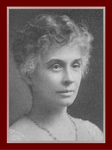

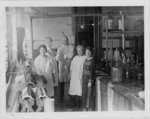
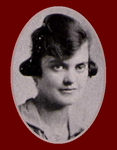
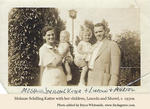

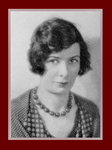

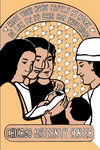
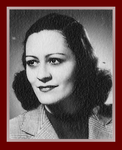
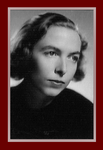
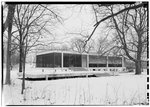
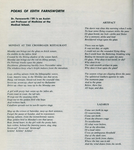

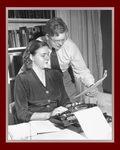

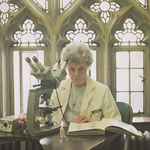
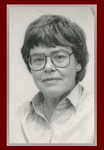

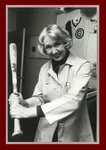
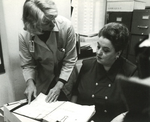
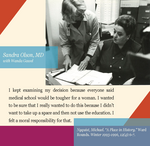
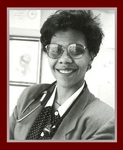
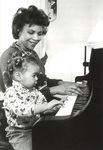%20copy.jpg)
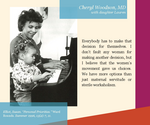

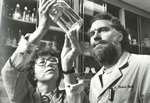.jpg)
